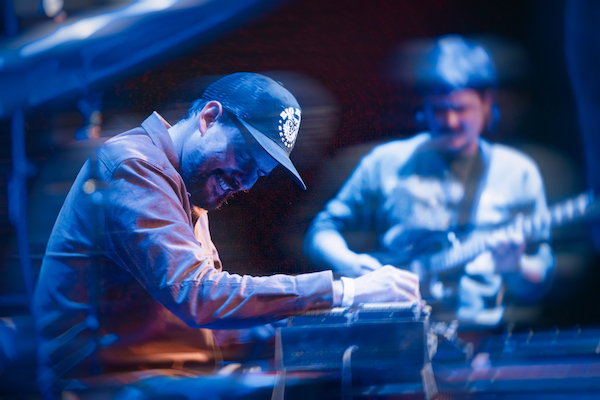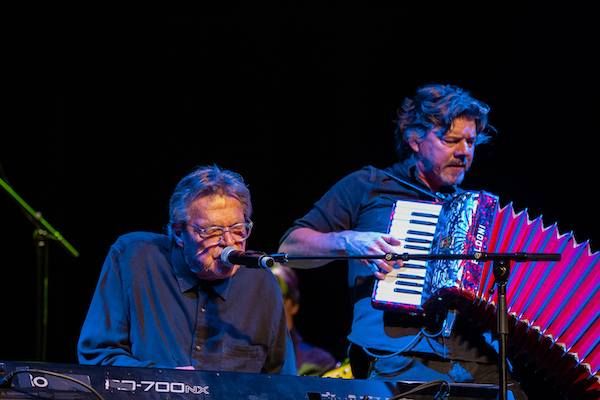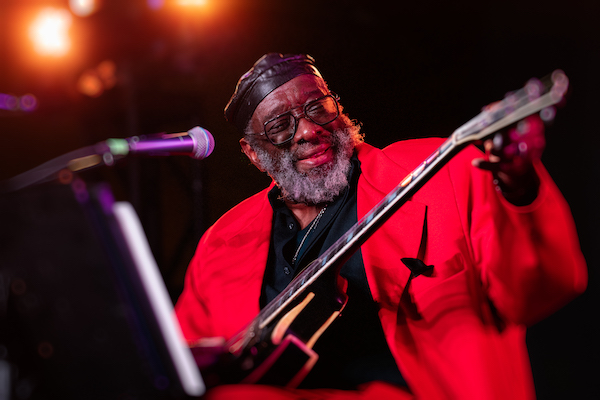Festival Review: Ten for Ten at Big Ears in Knoxville
By Noah Schaffer
In honor of Big Ears’ 10th edition, here’s a look at 10 of my favorite festival moments.

Veteran Nashville-based musician Rich Ruth in action at Big Ears. Photo: Billie Wheeler
To get a sense of the overwhelming abundance of creative music that was on tap at the Big Ears Festival in Knoxville (March 30-April 2), it might be worth considering the artists I missed: Charles Lloyd, Christian McBride, Bill Frisell (performing with both a jazz quartet and a symphony orchestra), Joe Lovano’s Trio Tapesty, Vijay Iyer with four different projects, Bela Fleck’s My Bluegrass Heart, Sierra Ferrell, Zoh Amba, and Vinicius Cantuaria. All great and important artists I would rush to see if they came to Boston. But with 17 concurrent venues running nearly nonstop for four days and nights, Big Ears is a festival that enables discovery and forces tough decisions. Good walking shoes are also recommended. For a city its size, Knoxville hosts many great venues, ranging from the ornate Tennessee Theater to the tiny Pilot Light, a classic rock dive. They’re all within walking distance, but they’re not all next to each other, so the treks added up to about six miles a day.
While most of the names on the Big Ears lineup work well outside of the commercial mainstream, the festival drew impressive audiences. Organizers said that, once free events were factored in, the weekend drew 45,000 attendees. Many shows played to capacity. After attending a fascinating interview with the nearly 90-year-old electronic pioneer Morton Subotnick and fellow inventive spirit Carl Stone, I tried to hear Subotnick’s performance the next day. No way — the lines stretched around the block. My fellow commiserators joked that Big Ears was probably the only place in North America, if not the world, where this would happen.
In honor of Big Ears’ 1oth edition, here’s a look at 10 of my favorite festival moments, listed in chronological order.

Texas songwriter Terry Allen at Big Ears. Photo: Cora Wagoner
Terry Allen — Texas songwriter Allen hasn’t been much of a troubadour in recent years; he has chosen to focus on his equally famous visual art. But he will put together a stellar band for occasional festival appearances. At Big Ears that included the soulful voice of Shannon McNally — and, for the encore of “Butt Naked,” one David Byrne, who was at the fest to record a podcast and screen his filmography.
Rich Ruth — There’s been a burst of creative steel guitar playing in recent years, much of it in the world of ambient music. Ambient steel was well-represented at Big Ears via solo sets by Luke Schneider and the band SUSS, who turned the small Jig & Reel club into a late-night living room. Another beautiful — and occasionally twangy — instrumental combo was led by guitarist Rich Ruth, who joked that steel player Whit Wright was one of the few musicians who’d played both Big Ears and the CMA Awards. (One of Wright’s other gigs is with arena country star Thomas Rhett.)
William Parker “Essential Tremors” — Beyond the concerts, Big Ears presented a plethora of exhibits, installations, film screenings, a roaming opera, and interviews. A last-minute talk cancellation led me to a screening of This Is National Wake, an engrossing documentary about musicians who braved early ’80s Apartheid to form a short-lived interracial punk/new wave band. The Essential Tremors NPR show/podcast taped several episodes of its program, in which musician guests were asked to name three songs that played a role in their development. (A co-host quipped that it was a way of getting deeper answers to the standard interview question “Who were your influences?”) William Parker, the titan of avant-garde jazz bass, chose Duke Ellington’s “Diminuendo and Crescendo in Blue” from the 1957 Newport Jazz Festival, which featured Paul Gonsalves soloing for 26 choruses. Asked why he chose the track, Parker’s answer was the verbal equivalent of that Gonsalves solo: he wove together richly detailed stories about his family and fellow musicians for a good 40 minutes without ever rambling or losing focus.

William Parker performing with the Mayan Space Station at Big Ears. Photo: Billie Wheeler
Gatos Do Sul — John Zorn came to Big Ears with an army of musicians, many of whom were given a chance to play their own music during the weekend. Jaw-dropping pianist Brian Marsella played several Zorn sets, but he also led his own group, Gatos Do Sul, which features the endlessly creative Brazilian percussionist Cyro Baptista. The music was impeccable, but the band supplied something not always associated with non-mainstream music — a lot of fun.
Staples Jr. Singers — Last year’s reissue of the ultra-obscure 1975 gospel LP When Do We Get Paid by the Staples Jr. Singers received so much attention that the Mississippi family group decided it was time to reform. Or, given that key member Annie Caldwell was still out on the Black gospel circuit with another family group, Annie & the Caldwell Singers, perhaps it was more of a rebranding for the hipster circuit. Either way, there was no lack of spirit either on stage or in the audience.
Mourning [A] BLKstar — Where have the soul music revolutionaries gone? Apparently to Cleveland, where this sprawling socially conscious band hails from. This self-described “gender and genre fluid” orchestra tackles racism, displacement, and mental health, but their gospel-rooted vocals, driving horns, and funky beats guarantee that great music comes along with the messages.

John Zorn at Big Ears. Photo: Cora Wagoner
John Zorn at 70 — Yes, iconoclast saxophonist and composer John Zorn has hit his 70s. Factor in surprise shows and he ended up being represented at a dozen sets at Big Ears. They ranged from his compositions for an acoustic guitar trio that included Bill Frisell, Julian Lage and Gyan Riley, to an all-hands-on-deck gathering for his long-running improv game, Cobra. Zorn also took out his horn to play his Jewish melodies with his New Masada Quartet. On Sunday night he played with a metal-jazz trio that included Trevor Dunn (the Mr. Bungle member who has since had a fruitful career as an improviser) and Slayer drummer Dave Lombardo. There was the expected squalling but also some blues.

James “Blood” Ulmer at Big Ears. Photo: Billie Wheeler
James “Blood” Ulmer — While there was plenty of new talent at Big Ears, the legends of creative music held their own. 89-year-old Phil Niblock created a drone that was accompanied by anthropological films and the bagpipes of David Watson. The Sun Ra Arkestra, whose spry leader Marshall Allen turns 99 next month, offered both their Afro-Futuristic anthems and a swinging rendition of Fletcher Henderson’s “Hocus Pocus.” (Allen, who is likely the oldest touring musician in the world, and the rest of the Arkestra will come to the Met Café in Providence on May 21.) Trio Imagination paired the longtime rhythm section of bassist Reggie Workman and drummer Andrew Cyrille with Cuban pianist David Virelles. Cyrille’s remarkable drum solo proved that at 83 he’s still exploring new percussive ideas. 81-year-old Wadada Leo Smith showed that he is likewise at the peak of his powers as a trumpeter, composer, and bandleader. (He’s unveiling a new work with Vijay Iyer at the University of Hartford on April 12.) And then there was James “Blood” Ulmer, the 83-year-old guitarist who has been at the vanguard of both jazz (with Ornette Coleman) and Black rock with his own projects. At Big Ears, Ulmer and his wah-wah pedal screamed the blues with a scorching trio that included bassist Mark Peterson and drummer G. Calvin Weston.

Bela Fleck and Bassekou Kouyate at Big Ears. Photo: Christian Stewart
Bela Fleck and Bassekou Kouyate — African music was a major presence at Big Ears. The only reason I didn’t see more of it was because so many of the acts have also made Boston appearances: Etran de L’Aïr recently put on a memorable show at Somerville’s Crystal Ballroom (which I saw), so that freed up a valuable Big Ears slot. Sona Jobarteh, the uplifting kora player from The Gambia, is set to perform at the Somerville Theater on April 22. The small slice of her Big Ears set that I caught indicated why there is (as of press time) exactly one ticket left for that Global Arts Live show. Bassekou Kouyate and Ngoni Ba will be at the Crystal Ballroom on April 16. Kouyate played a secret show (announced at an hour’s notice) with Bela Fleck. The Afro-bluegrass duo makes a lot of sense, since, as Fleck pointed out, Kouyate’s ngoni is the African predecessor of Fleck’s banjo. The two had a ball with their impromptu duets on both African and Earl Scruggs numbers. So did the audience.
Marc Ribot and Los Cubanos Postizo — Guitar hero Marc Ribot was all over Big Ears. Just like last year, he performed in a wide variety of formats. With the Jazz Bins he reveled in the kind of organ soul-jazz that he played at the start of his career. His metal side was displayed in full force when he was part of a John Zorn “Bagatelles” performance. To cap off the festival, Ribot revived his celebrated turn with the band Los Cubanos Postizos. They dived into a slightly warped take on Afro-Cuban grooves, accented by the impish organ of part-time Bostonian and NEC faculty member Anthony Coleman. (He had played, the day before, a mesmerizing solo piano set). The band came out in wigs to protest Tennessee’s attempt at banning drag, a reminder that when state-sponsored attempts to ban expression (or to silence select groups simply for existing) are on the rise, the arts are even more valuable.
Noah Schaffer is a Boston-based journalist and the co-author of gospel singer Spencer Taylor Jr.’s autobiography A General Becomes a Legend. He also is a correspondent for the Boston Globe and DigBoston, and spent two decades as a reporter and editor at Massachusetts Lawyers Weekly and Worcester Magazine. He has produced a trio of documentaries for public radio’s Afropop Worldwide, and was the researcher and liner notes writer for Take Us Home – Boston Roots Reggae from 1979 to 1988. He is a 2022 Boston Music Award nominee in the music journalism category. In 2022 he co-produced and wrote the liner notes for The Skippy White Story: Boston Soul 1961-1967, which was named one of the top boxed sets of the year by the New York Times.
Tagged: Bassekou Kouyate, Bela Fleck, Big Ears Festival, Gatos Do Sul, James Blood Ulmer, John Zorn, Marc Ribot and Los Cubanos Postizo


Man, you missed almost all of the best stuff!
Zorn solo set at the point was dunk!
Zorn new masada quartet was dunk!
Rafiq Bhatia dunked on most everyone!
The Bad Plus dunked on fools from the Mill & Mine!!
Bill Frissell’s set was DUNKING!
William Parker’s new mayan thing with ava mendoza DUNKED ON MULTIPLE FOOLS!
Great write-up. I saw 5 of your 10, and all were exquisite. (I also missed all of the sets you listed at the top, because you can’t see it all!) Big Ears is the best festival in America, I’m already dreaming of next year.
So many good sets.
Both Lonnie Holley sets were transcending.
Joe Levano trio, superb.
Exploding Star Orchestra was next generation’s Bitches Brew.
And Mary Halverson!!
And Makaya McCraven!!
Cecile McLorin Salvant
Aurora Neelon’s Monocle Ensemble— off the chain!
And John Zorn’s finale of Cobra — for the spectacle of it all.
So much to hear and so many choices to make.
Looking forward to next year.